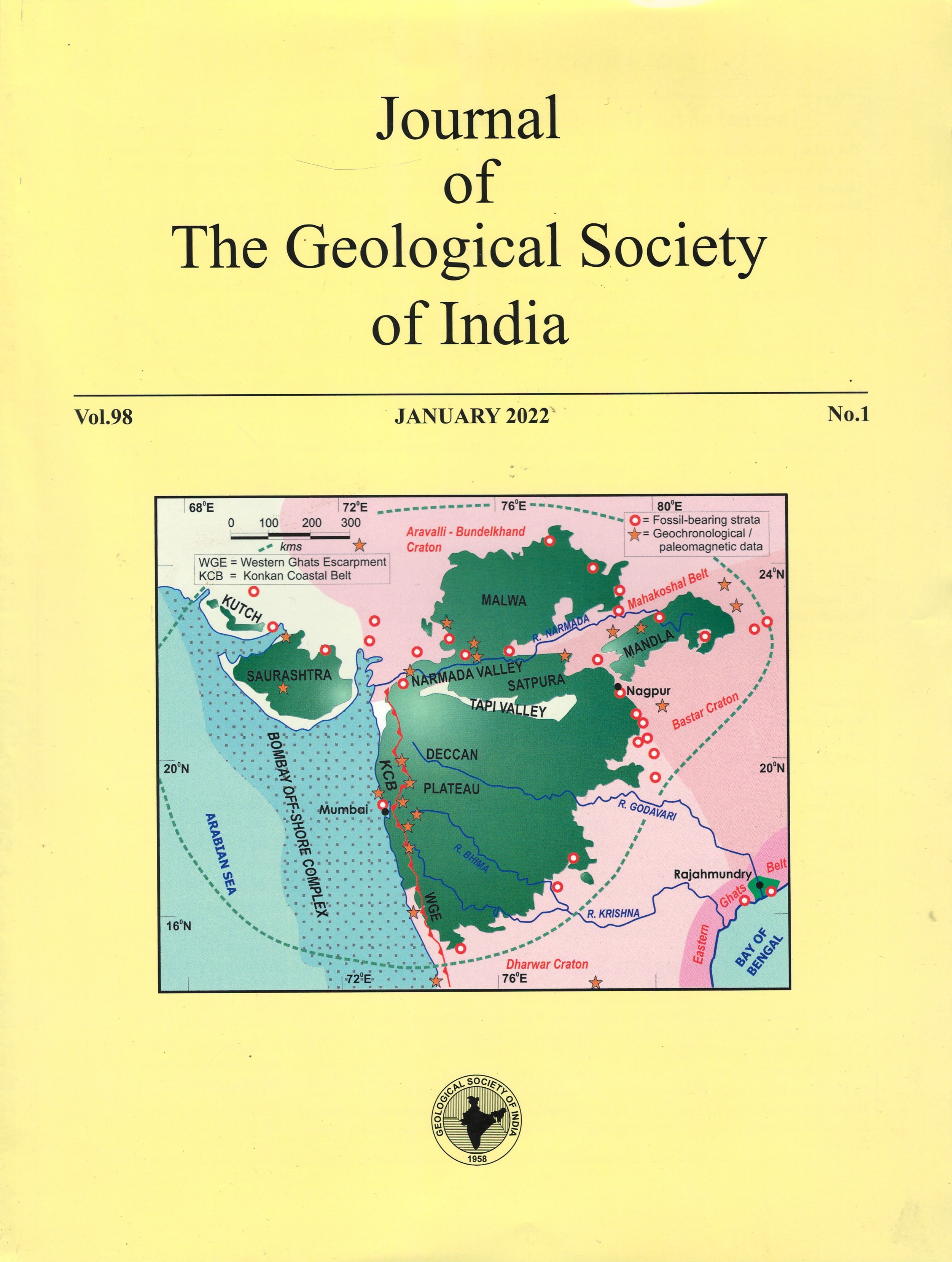Aquifer Mapping in Parts of Murshidabad and Adjoining Birbhum Districts, West Bengal, India
DOI:
https://doi.org/10.1007/s12594-022-1935-zKeywords:
No keywordsAbstract
Aquifer Mapping has been carried out in an area of 2660 sq km in Ganga Basin lying on the west of River Bhagirathi. The present area comprises a total of 13 C. D. blocks, 4 north-eastern C. D. blocks of Birbhum district, and 9 western C. D. blocks of Murshidabad district, in the state of West Bengal. Present area is entirely covered by Quaternary alluvium. This study revealed the existence of multiple aquifer groups characterised by inherent litho-logical properties and often typical geo-morphological setup, distribution in space and geological time, and ground water potentiality. The geogenic contamination of ground water by arsenic and fluoride poses a serious health problem in the area. The objective of the present study is to delineate the subsurface aquifer groups in successive geological formations up to targeted depth of exploration of 325 m, graphically represent them by 3D model & 2D sections, to generate geo-environmental data of aforesaid contaminants in ground water of individual aquifer groups separately and to provide a plausible explanation behind this contamination. This study is helpful for identification of aquifers, which bear potable ground water and those, which are under stress and need immediate intervention for sustainable management.
Downloads
Metrics
Issue
Section
Downloads
Published
How to Cite
References
Acharyya, S.K., Chakraborty, P., Lahiri, S., Raymahashay, B.C., Guha, S. and Bhowmick, A. (1999) Arsenic poisoning in the Ganges delta. Nature, v.401, pp.545.
Acharyya, S.K., Lahiri, S., Raymahashay, B.C. and Bhowmick, A. (2000) Arsenic toxicity of ground water in parts of the Bengal Basin in India & Bangladesh: The role of Quaternary Stratigraphy and Holocene sea- level fluctuation. Environ. Geol. Jour., v.39(10), pp.1127-1137.
Ayoob, S. and Gupta, A. (2006) Fluoride in drinking water: a review on the status and stress effects. Critical Reviews in Environmental Science and Technology Jour., v.36, pp 433-487.
Bhattacharya, P., Chatterjee, D. and Jacks, G. (1997) Occurrence of arseniccontaminated groundwater in alluvial aquifers from Delta Plains, eastern India: options for safe drinking water supply. Internat. Jour. Water Resour. Develop., v.13(1), pp.79-92.
BIS (IS 10500: 2012) Indian Standard Drinking Water – Specification (Second Revision).
Brahma, S. (2013) Ground water pollution by arsenic in and around Purbasthali, Bardhaman district. National Seminar Vol. “Groundwater Management, Governance and Sustainability”, 7-8 Nov., Jadavpur University.
Brahma, S. (2018) Geogenic fluoride contamination in two diverse geological settings in West Bengal. In: D. Saha et al. (Eds.). Clean and Sustainable Groundwater in India. Springer Hydrogeology, Singapore, pp.39-60.
Brindha, K. and Elango, L. (2011) Fluoride in Groundwater: Causes, Implications and Mitigation Measures. In: Monroy, S.D. (Ed.), Fluoride Properties, Applications and Environmental Management, pp.111-136.
Gurung, J.K., Hiroaki I. and Khadka M.S. (2005) Geological and geochemical examination of arsenic contamination in groundwater in the Holocene Terai Basin, Nepal. Environ. Geol. Jour., v.49(1), pp.98-113.
Hudak, P.F. and Sanmanee, S. (2003) Spatial patterns of nitrate, chloride, sulfate, and fluoride concentrations in the woodbine aquifer of northcentral Texas. Environ. Monit. Assess. Jour., v.82, pp.311–320.
Khan, A.A., Hoque, S., Huq, S.M.I., Kibria, K.Q. and Hoque, M. (2003). Evidence of bacterial activity in the release of arsenic – a case study from the Bengal delta of Bangladesh. Jour. Geol. Soc. India, v.61(2), pp.209- 214.
McArthur, J.M., Ravenscroft, P., Safiullah, S. and Thirlwall, M.F. (2001) Arsenic in groundwater: testing pollution mechanisms for sedimentary aquifers in Bangladesh. Water Resour. Res., v.37, pp.109-117.
Nickson, R.T., McArthur, J.M., Ravenscroft, P., Burgess, W. and Ahmed, K.M. (2000) Mechanism of arsenic release to ground water, Bangladesh and West Bengal. Appl. Geochem. Jour., v.15(4), pp.403- 413.
Piper, A.M. (1944) A graphic procedure in the geochemical interpretation of water-analyses. Eos, Trans. Amer. Geophys. Union, v.25(6), pp.914– 928.
Prasad, K. and Shukla, J.P. (2014) Identification of source of fluoride contamination in basaltic terrain. Internat. Jour. Remote Sens. Geosci. (IJRSG), v.3(2), pp.40-43.
Ravenscroft P., McArthur J.M. and Hoque B.A. (2001) Geochemical and Palaeohydrological controls on pollution of groundwater by arsenic. In: Chappell, W.R., Abernathy, C.O. and Calderon, R. (Eds.), Arsenic Exposure and Health Effects IV. Elsevier Science Ltd., Oxford, pp.53-78.
Roy Chowdhury, T., Basu, G.K., Mandal, B.K., Biswas, B.K., Samanta, G., Chowdhury, U.K., Chanda, C.R., Lodh, D., Roy, S.L., Saha, K.C., Roy, S., Kabir, S., Quamruzzaman, Q. and Chakraborti, D. (1999) Arsenic poisoning in the Ganges Delta. Nature, v.401, pp.545-546.
Sengupta, M.K., Hossain, A., Ahamed, S., Das, B., Nayak, B., Pal, A., Mukherjee, A. Rahman, M.M., Chowdhury, U.K., Biswas, B.K., Roy Chowdhury, T., Mondal, B.K., Samanta, G., Chatterjee, A, Das, D., Lodh, D., Chakraborti, D, Mukherjee, S.C., Pati, S., Dutta, R.N. and Saha, K.C. (2009) Groundwater arsenic contamination situation in West Bengal, India: a nineteen year study. Bhujal News. Quart. Jour., v.24(2 & 3).
Shah, B.A. (2010) Arsenic-contaminated groundwater in Holocene sediments from parts of Middle Ganga Plain, Uttar Pradesh, India. Curr. Sci., v.98(10).
So, H.U., Dieke, P., Mai, L.V., Pham, T.K. T., Kazmierczak, J., Dao, V.N., Pi, K., Koch, C.B., Pham, H.V. and Jakobsen, R. (2018) Arsenic in Holocene aquifers of the Red River Floodplain, Vietnam: effects of sediment - water interactions, sediment burial age and groundwater residence time. Geochim. Cosmochim. Acta, v.225, pp.192-209.
Valenzuela-Va´squez, L., Ramýrez-Herna´ndez, J., Reyes-Lopez, J., Sol-Uribe, A. and LazaroMancilla, O. (2006) The origin of fluoride in groundwater supply to Hermosillo City, Sonora, Mexico. Environ. Geol. Jour., v.51, pp.17-27.
World Health Organization (2020) Guidelines for drinking-water quality. Fourth Edition Incorporating The First Addendum.

 Supriya Brahma
Supriya Brahma






